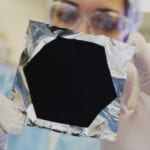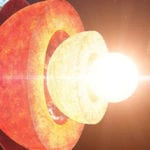 History
History  History
History  Weird Stuff
Weird Stuff 10 Everyday Products Surprisingly Made by Inmates
 Movies and TV
Movies and TV 10 Actors Dragged out of Retirement for One Key Role
 Creepy
Creepy 10 Lesser-Known Shapeshifter Legends from Around the World
 Animals
Animals 10 Amazing Animal Tales from the Ancient World
 Gaming
Gaming 10 Game Characters Everyone Hated Playing
 Books
Books 10 Famous Writers Who Were Hypocritical
 Humans
Humans 10 of the World’s Toughest Puzzles Solved in Record Time
 Mysteries
Mysteries 10 Scientific Mysteries We Don’t Fully Understand
 Weird Stuff
Weird Stuff 10 Celebrities Who Have Admitted to Alien Encounters
 History
History Ten Revealing Facts about Daily Domestic Life in the Old West
 Weird Stuff
Weird Stuff 10 Everyday Products Surprisingly Made by Inmates
 Movies and TV
Movies and TV 10 Actors Dragged out of Retirement for One Key Role
Who's Behind Listverse?

Jamie Frater
Head Editor
Jamie founded Listverse due to an insatiable desire to share fascinating, obscure, and bizarre facts. He has been a guest speaker on numerous national radio and television stations and is a five time published author.
More About Us Creepy
Creepy 10 Lesser-Known Shapeshifter Legends from Around the World
 Animals
Animals 10 Amazing Animal Tales from the Ancient World
 Gaming
Gaming 10 Game Characters Everyone Hated Playing
 Books
Books 10 Famous Writers Who Were Hypocritical
 Humans
Humans 10 of the World’s Toughest Puzzles Solved in Record Time
 Mysteries
Mysteries 10 Scientific Mysteries We Don’t Fully Understand
 Weird Stuff
Weird Stuff 10 Celebrities Who Have Admitted to Alien Encounters
10 Lights That Have Puzzled Science
When you think of strange light phenomena, the first things that likely come to mind are rainbows, aurora borealis, or halos around the Sun. While at any given moment, you’re probably not going to look outside and see any of these things, there are other events that have dumbfounded people for years.
Our world has played host to a wide array of optical oddities. The origins of these strange lights aren’t immediately apparent, and they have both spawned legends and brought scientific inquiry. Explanations have been given for some; others remain not very well-understood.
10 Sprites, Jets, And Elves (Oh My!)
![]()
While these oddities are more easily seen with a low-light camera, it is possible to see red sprites in the atmosphere with the naked eye. Jets are blue in color and can often look like lightning shooting upward from a cloud.[1] Elves, the singular of which is “elve,” are flattened phenomena seen above thunderstorms and are also usually reddish in color.
These three hard-to-catch happenings are all examples of upper atmospheric lightning. Many times, they are found while looking for something else, such as meteor showers. As technology gets better, scientists are finding that there is a myriad of different kinds of atmospheric phenomena.
9 Hessdalen Lights
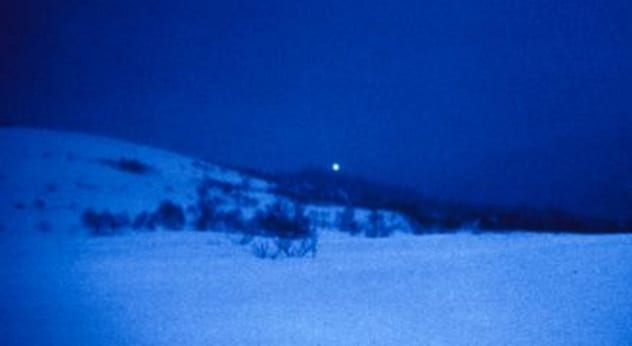
These lights call the Hessdalen Valley in Norway their home. There has yet to be a distinct explanation for these lights, which range in color, strength, and length of occurrence. Many organizations, including UFO-Norge, a Norwegian organization, have taken interest in the lights, with limited results.
The event happens very low in the atmosphere, which makes it different from many other occurrences, which happen more frequently the higher you go. It appears in a doublet formation with surprising consistency and predictability.
A report completed in 2007 reveals a better hypothesis using cameras and intensity plots. This technology was necessary for this report due to the ease of mixing up lights from human sources and the Hessdalen lights themselves. The plots tell little of what the lights actually contain but point to one culprit: gas and dust. The dust floats up to meet the gas(es), which then combust until the fuel between the two is burned out.[2]
8 Marfa Ghost Lights
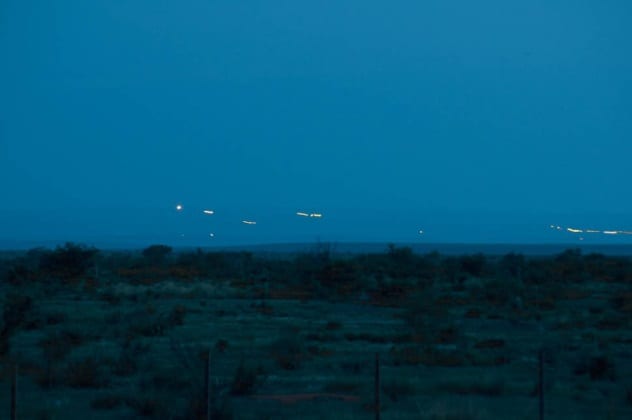
As the name suggests, these lights are found near Marfa, Texas. The inhabitants of Marfa, having grown accustomed to these little guys, can attest that this is a friendly ghost light. They can be seen day or night, though the area, optimized for tourists since 2003, has a limited viewing time for visitors. These lights have been sighted since cowboys herded cattle on the prairies.[3]
Skeptics suggest that the lights are caused by headlights from the nearby highway or campfires at night. Others believe it is an effect caused by the fluctuating temperatures due to Marfa being 1,429 meters (4,688 ft) above sea level. The warm and cold air refracts the light from sources in a way that’s not possible to see up close.
7 Ozark Spook Light

This shy guy calls Oklahoma its home. Due to it being easier to see from the east, it has also been given the name the Hornet Spook Light after the nearby town of Hornet, Missouri. This ball of curiosity varies in size but is almost always an orange color. No one has been able to decisively pinpoint the origin of this will-o’-the-wisp, despite it having been seen for hundreds of years, dating back to the Native Americans walking the Trail of Tears.
Explanations for this light are similar to that of the Marfa Ghost Lights—cars, billboards, or gaseous leakage. The legends around it often involve someone losing something and searching in the dark for it with their lantern. Another involves two lovers who eloped and were caught by a hunting party. The two leaped to their deaths into the Spring River, and their spirits float together ever since.[4]
6 Brown Mountain Lights
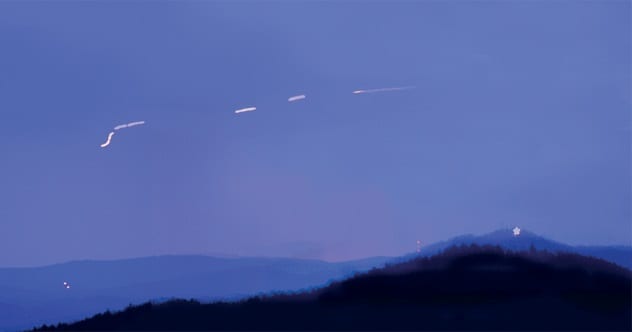
There are many viewpoints to observe these lights in North Carolina. When first investigated, it was thought that they were nothing but headlights in the distance being refracted through the atmosphere. This common explanation for these occurrences was later thought to be disproved when the lights persisted after a flood, and there was no traffic (and no boats).
Other skeptics have found that there are actually two different phenomena that occur at the different viewing points. From Wiseman’s View, it appeared as though there were lights under the trees in the Brown Mountains, as if there were people waving lights around themselves. A Cherokee tale tells of the ghosts of wives looking for their husbands who were lost in war. These lights take a back seat to what others believe are the real Brown Mountain Lights.
The Brown Mountain Lights are in the sky, not the trees. It was first thought that a locomotive over the hill was casting its lights over the mountain, which would explain why locals would see the light at the same time every night (as long as the train ran on time). The model of train in question, however, had two lights, not one. It was later found that written reports of the lights came around the time electric lights were placed in the area. The lights being refracted into the sky were visible if viewed from a specific point, which is why they would linger and disappear. If one walked up the path too far, all they would have to do is walk back down to see the light again.[5]
5 Chaleur Fire Ship
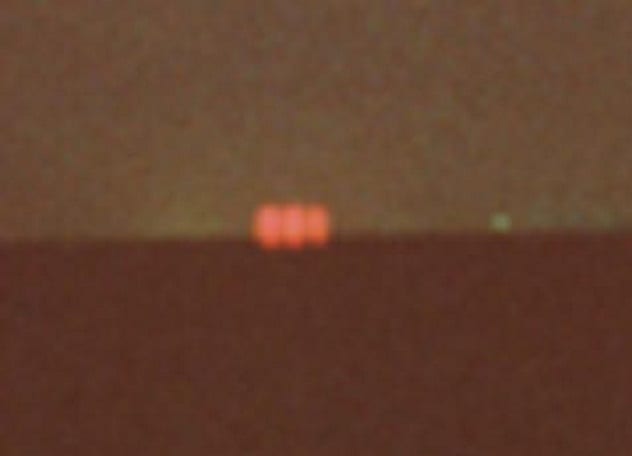
Legend has it that this is the ghost of a pirate ship that was destroyed for kidnapping two Native American girls. The blazing aparrition travels through Canada’s Chaleur Bay, the host of the unfortunate event. The crew can still be seen operating the ship, raising and lowering sails. Science claims that this occurs because of natural gases beneath the waves, but the locals will tell you this has been happening ever since Captain Craig’s ship sank.
Science doesn’t have a good grasp on this one. Some have sailed out to the phenomenon, only to find it keeps the same distance no matter how far out they go. A telescope renders no details that you couldn’t just see by looking at it. There’s no solid state of the ship. Sometimes it lingers; other times, it appears and disappears just as fast.
Other theories are gases released by submarines, or bioluminescent life. The latter has been frowned upon by scientists because the Fire Ship still occurs even in winter, when the water is frozen.[6]
4 Fata Morgana
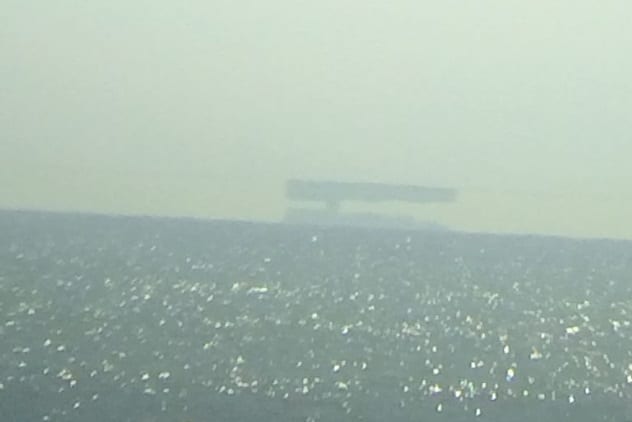
Seen typically over water, these grand masters of trickery can confuse and stupefy. Experienced seagoers are able to see through their facade, though. The explanation for these is images on the water being refracted, flipped upside down, and stretched like rubber bands. These images can be in the shape of ships or pieces of land.
Fata Morganas can also occur on land. Essentially, an image is refracted from past the horizon into our eye’s view, causing things to appear where they should not be. Fata Morganas are thought to be the modern-day explanation for the legend of the Flying Dutchman, a ship over the horizon being cast into the view of another vessel, making it appear to not touch the water.[7]
3 Green Flash
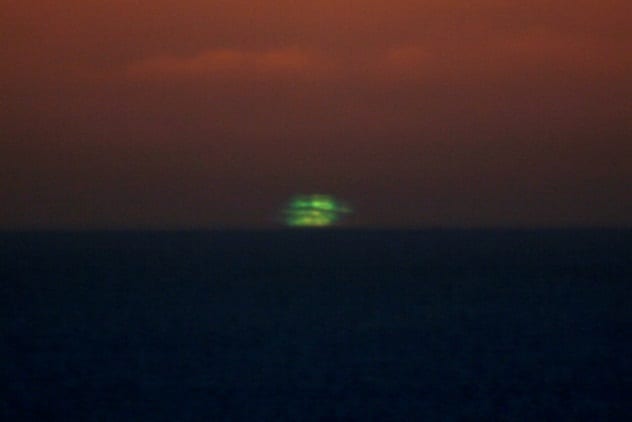
This event is possible to see if you have the right timing when the Sun rises or sets. The Sun will appear to have a small green rim around it, and through the effects of stretching that happens similarly with Fata Morganas, you can spot this green flash above the Sun.
This is most easily seen if you’re viewing the Sun over the water in unpolluted air.[8] Rarely, the flash appears blue instead of the more common green.
2 Sundog
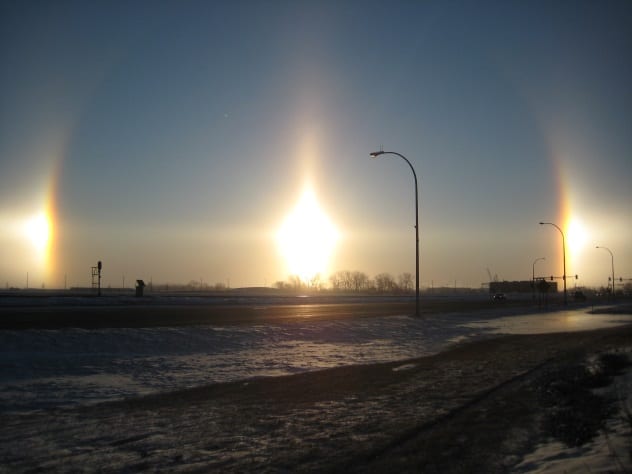
Also known, more accurately, as parhelia (singular “parhelion”), sundogs are similar to halos, though they make two crescents that are always to the left and right of the Sun. These crescents are positioned at a 22-degree angle from the Sun. This occurs due to ice crystals in the atmosphere refracting the Sun’s light at just the right angles.
An interesting event that involved a Sundog was when NASA’s Solar Dynamics Observatory (SDO) was launched. There was a sundog present that day, and it happened to be in the trajectory of the SDO. Not only did the SDO destroy the sundog, but it caused the ice crystals in the air to spin. This caused a blast of white light to follow the SDO as it rose. It took some time for the scientists to figure out this secondary light phenomenon.[9]
1 Moonbows
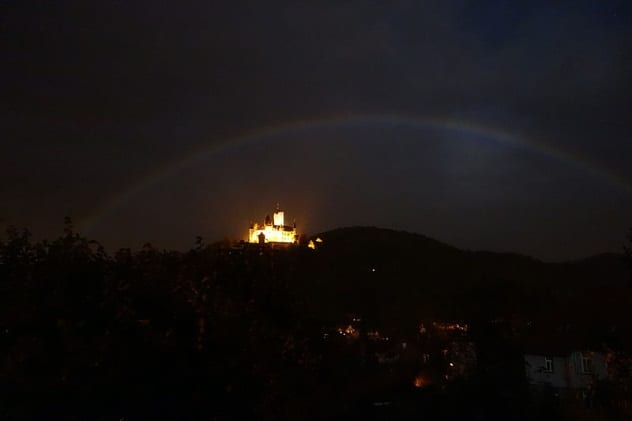
Similar to rainbows (or sunbows, as I now think of them), water must be present in the air for moonbows to be seen. The Moon must be at its fullest or near its fullest to cast enough light. Being low in the sky to light the water at is also a must.
Moonbows are more easily seen near waterfalls during a full Moon at dusk. Yes, it is possible to have a double moonbow.[10]
Dental assistant by day, writer by free time. I have a recent blog which is currently only dental-themed, however I’m not afraid to write about other subjects that I don’t have five years of experience with. For the blog, see www.daybreakwriting.com.
For more phenomena that have perplexed scientists, check out 10 Solar System Mysteries That Baffle Our Best Scientists and 10 Strange Phenomena That Stumped Experts.




